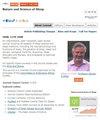足月新生儿在出生后早期不同睡眠状态下的定量脑电图分析
IF 3.4
2区 医学
Q2 CLINICAL NEUROLOGY
引用次数: 0
摘要
背景:新生儿的睡眠对其生长发育至关重要,但人工解读原始图像耗时耗力。定量脑电图(QEEG)在客观性和方便性方面具有显著优势,可用于研究新生儿的睡眠模式。然而,有关健康新生儿睡眠模式的研究仍然很少。本研究旨在找出能区分新生儿不同睡眠周期的 QEEG 标记,并分析不同睡眠阶段的 QEEG 改变与月经后年龄的关系:方法:2023年9月至2024年2月期间,复旦大学附属妇产科医院新生儿科收治的足月新生儿被纳入本研究。新生儿出生后 1-7 天内的脑电图(EEG)记录均来自 37-42 周龄的新生儿。研究采用 ROC 曲线来评估不同睡眠阶段的 QEEG 特征,包括振幅、范围 EEG(rEEG)、频谱密度和连接性。此外,还进行了回归分析,以研究这些 QEEG 特征与月经后年龄之间的关联:结果:α频段的频谱差异_F3是区分活跃睡眠(AS)和安静睡眠(QS)最有效的指标。在区分活跃睡眠(AS)和安静睡眠(QS)时,θ频段的频谱差异_C4是最有效的,而δ频段的频谱差异_P4则在区分安静睡眠(QS)和活跃睡眠(W)时表现出色。在AS和QS阶段,所有监测脑区的δ频段熵显著增加,θ频段的频谱相对功率也显著增加,这与经后年龄(PMA)相关:结论:在清醒和各种睡眠状态下,频谱差异具有最高的分辨能力。观察到的新生儿 QEEG 与 PMA 相关的改变模式与新生儿睡眠的成熟过程一致,为预测和评估大脑发育结果提供了启示。本文章由计算机程序翻译,如有差异,请以英文原文为准。
Quantitative Electroencephalography in Term Neonates During the Early Postnatal Period Across Various Sleep States
Background: Neonatal sleep is pivotal for their growth and development, yet manual interpretation of raw images is time-consuming and labor-intensive. Quantitative Electroencephalography (QEEG) presents significant advantages in terms of objectivity and convenience for investigating neonatal sleep patterns. However, research on the sleep patterns of healthy neonates remains scarce. This study aims to identify QEEG markers that distinguish between different neonatal sleep cycles and analyze QEEG alterations across various sleep stages in relation to postmenstrual age.
Methods: From September 2023 to February 2024, full-term neonates admitted to the neonatology department at the Obstetrics and Gynecology Hospital of Fudan University were enrolled in this study. Electroencephalographic (EEG) recordings were obtained from neonates aged 37– 42 weeks, within 1– 7 days post-birth. The ROC curve was employed to evaluate QEEG features related to amplitude, range EEG (rEEG), spectral density, and connectivity across different sleep stages. Furthermore, regression analyses were performed to investigate the association between these QEEG characteristics and postmenstrual age.
Results: The alpha frequency band’s spectral_diff_F3 emerged as the most potent discriminator between active sleep (AS) and quiet sleep (QS). In distinguishing AS from wakefulness (W), the theta frequency’s spectral_diff_C4 was the most effective, whereas the delta frequency’s spectral_diff_P4 excelled in differentiating QS from W. During AS and QS phases, there was a notable increase in entropy within the delta frequency band across all monitored brain regions and in the spectral relative power within the theta frequency band, correlating with postmenstrual age (PMA).
Conclusion: Spectral difference showcases the highest discriminative capability across awake and various sleep states. The observed patterns of neonatal QEEG alterations in relation to PMA are consistent with the maturation of neonatal sleep, offering insights into the prediction and evaluation of brain development outcomes.
Methods: From September 2023 to February 2024, full-term neonates admitted to the neonatology department at the Obstetrics and Gynecology Hospital of Fudan University were enrolled in this study. Electroencephalographic (EEG) recordings were obtained from neonates aged 37– 42 weeks, within 1– 7 days post-birth. The ROC curve was employed to evaluate QEEG features related to amplitude, range EEG (rEEG), spectral density, and connectivity across different sleep stages. Furthermore, regression analyses were performed to investigate the association between these QEEG characteristics and postmenstrual age.
Results: The alpha frequency band’s spectral_diff_F3 emerged as the most potent discriminator between active sleep (AS) and quiet sleep (QS). In distinguishing AS from wakefulness (W), the theta frequency’s spectral_diff_C4 was the most effective, whereas the delta frequency’s spectral_diff_P4 excelled in differentiating QS from W. During AS and QS phases, there was a notable increase in entropy within the delta frequency band across all monitored brain regions and in the spectral relative power within the theta frequency band, correlating with postmenstrual age (PMA).
Conclusion: Spectral difference showcases the highest discriminative capability across awake and various sleep states. The observed patterns of neonatal QEEG alterations in relation to PMA are consistent with the maturation of neonatal sleep, offering insights into the prediction and evaluation of brain development outcomes.
求助全文
通过发布文献求助,成功后即可免费获取论文全文。
去求助
来源期刊

Nature and Science of Sleep
Neuroscience-Behavioral Neuroscience
CiteScore
5.70
自引率
5.90%
发文量
245
审稿时长
16 weeks
期刊介绍:
Nature and Science of Sleep is an international, peer-reviewed, open access journal covering all aspects of sleep science and sleep medicine, including the neurophysiology and functions of sleep, the genetics of sleep, sleep and society, biological rhythms, dreaming, sleep disorders and therapy, and strategies to optimize healthy sleep.
Specific topics covered in the journal include:
The functions of sleep in humans and other animals
Physiological and neurophysiological changes with sleep
The genetics of sleep and sleep differences
The neurotransmitters, receptors and pathways involved in controlling both sleep and wakefulness
Behavioral and pharmacological interventions aimed at improving sleep, and improving wakefulness
Sleep changes with development and with age
Sleep and reproduction (e.g., changes across the menstrual cycle, with pregnancy and menopause)
The science and nature of dreams
Sleep disorders
Impact of sleep and sleep disorders on health, daytime function and quality of life
Sleep problems secondary to clinical disorders
Interaction of society with sleep (e.g., consequences of shift work, occupational health, public health)
The microbiome and sleep
Chronotherapy
Impact of circadian rhythms on sleep, physiology, cognition and health
Mechanisms controlling circadian rhythms, centrally and peripherally
Impact of circadian rhythm disruptions (including night shift work, jet lag and social jet lag) on sleep, physiology, cognition and health
Behavioral and pharmacological interventions aimed at reducing adverse effects of circadian-related sleep disruption
Assessment of technologies and biomarkers for measuring sleep and/or circadian rhythms
Epigenetic markers of sleep or circadian disruption.
 求助内容:
求助内容: 应助结果提醒方式:
应助结果提醒方式:


